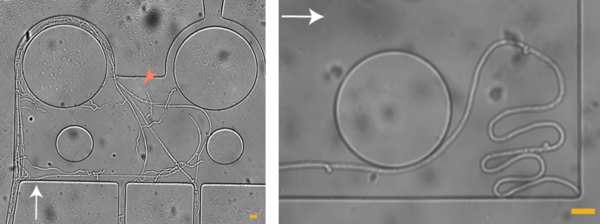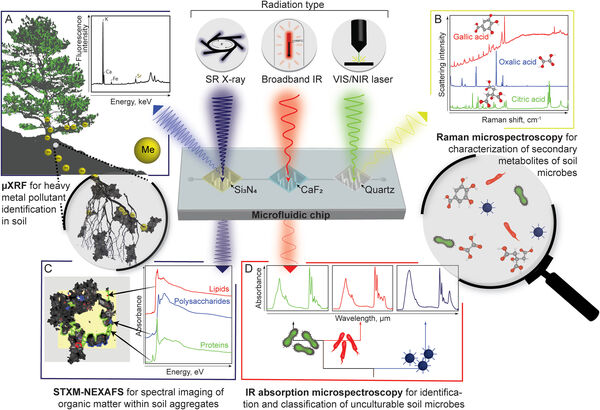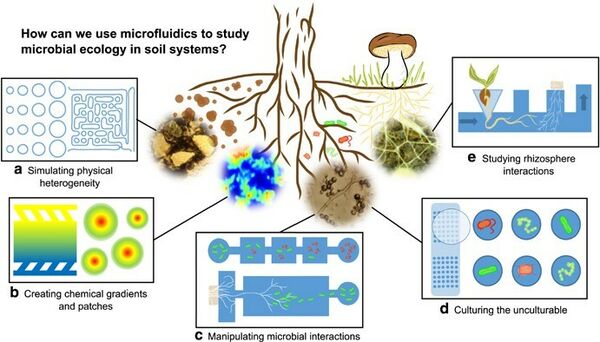Ecology-on-a-chip
The SoilChip project
The underground may at first sight look lifeless, but is actually teeming with bacteria, fungi and other microscopic organisms. Still they are hard to study since the soil is so dark and opaque. To solve this we are developing transparent chip models of the underground in the SoilChip project, a collaboration between Pelle Ohlsson at Biomedical Engineering and the group of Edith Hammer at Microbial Ecology.
Examples of soil ecology questions to approach using microfluidics. (Adapted from publication 3 under a Creative Commons Attribution-NonCommercial-NoDerivs 4.0 International License.)
How do soil microorganisms live and interact?
Using our transparent microchips we can follow the lifes of bacteria, fungi and other microscopic organisms and see how they explore their world, what obstacles they can and cannot pass, what strategies they use to search for food and how they interact when they meet.

Fungal hyphae growing and meeting turns and corners in Soil Chip. (Adapted from publication 1 under a Creative Commons Attribution 4.0 International License.)
How do bacteria and fungi affect climate change?
The soil is full of dead organic material, but luckily not all of it is eaten by bacteria and fungi and released into the atmosphere as carbon dioxide. One theory is that it is because the material is hidden in the underground labyrinths and that various nutrients are too spread out. We make microchip models to understand this, aiming at farming methods that help the soil take up carbon.
How do microplastics affect soil organisms?
Microplastics have recently been identified as a threat to aquatic life, but little is known about how it affects the microorganisms in the soil. We use transparent microchips to study what happens when they meet.
How do fungi affect their chemical environment?
Lund University harbours one of the world’s most modern light sources, Max IV. We use synchrotron light and other spectroscopic methods to study how fungi affect their local chemical environment.

Examples of how to study the chemical environment of soil microbes by combining spectroscopy and microfluidics. (Adapted from publication 2 under a Creative Commons CC-BY License.)
Popular science, radio, TV, pod and poem
Radio P4 interview with Edith Hammer (February 2021)
"Finding food in a labyrinth – an hyphae story" by MicroBites (February 2021) (French)(Dutch)
"Olika personligheter i svamparnas värld" (forskning.se January 2021)
The story behind the project (Nature Research Microbiology Community January 2021)
Poem about the Soil Chip by Sam Illingworth also featured in his podcast "The Poetry of Science" February 2021 (Spotify link):
Selected publications
- Fungal foraging behaviour and hyphal space exploration in micro-structured Soil Chips, Kristin Aleklett, Pelle Ohlsson, Martin Bengtsson, Edith C. Hammer, ISME Journal (Nature Publishing Group), 2021, doi:10.1038/s41396-020-00886-7
- Shining new light into soil systems: Spectroscopy in microfluidic soil chips reveals microbial biogeochemistry, Milda Pucetaite, Pelle Ohlsson, Per Persson, Edith Hammer, Soil Biology and Biochemistry, 2021, doi: 10.1016/j.soilbio.2020.108078
- Build your own soil: exploring microfluidics to create microbial habitat structures, Kristin Aleklett, E. Toby Kiers, Pelle Ohlsson, Thomas S. Shimizu, Victor E. A. Caldas, Edith C. Hammer, ISME Journal (Nature Publishing Group), 2018, doi:10.1038/ismej.2017.184
- Development of a microfluidic chip with a chemical gradient for hyphal growth, David Wernbro, master’s thesis Lund University 2015, supervisors: Pelle Ohlsson and Edith Hammer
- Chemical gradient over maze-microsystem for fungal hyphal growth, Sofia Lam, bachelor thesis Lund University 2015, supervisors: Pelle Ohlsson and Edith Hammer

